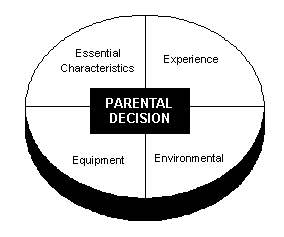Snowmobiles and Youth Table of Contents
 Snowmobiling
can be an activity enjoyed by all members of the family. Young
people of all ages and abilities are at risk as operators,
passengers, and pedestrians during snowmobile operation. The
research suggests young people's risk for injury while snowmobiling
is highest when not supervised by a responsible adult; at
dawn, dusk, and dark; frozen bodies of water; and when there
is increased probability of encountering snowmobilers operating
under the influence of alcohol. Snowmobile-related injuries
to young people are often a result of risk-taking behaviors
(excessive speed, alcohol use, and night-time driving by adults.
Snowmobiling
can be an activity enjoyed by all members of the family. Young
people of all ages and abilities are at risk as operators,
passengers, and pedestrians during snowmobile operation. The
research suggests young people's risk for injury while snowmobiling
is highest when not supervised by a responsible adult; at
dawn, dusk, and dark; frozen bodies of water; and when there
is increased probability of encountering snowmobilers operating
under the influence of alcohol. Snowmobile-related injuries
to young people are often a result of risk-taking behaviors
(excessive speed, alcohol use, and night-time driving by adults.
The age of the young person should be used only as a guideline. Remember, all young people develop and mature at different rates. A youth's physical development and maturity determines his or her ability to perform certain tasks safely. When young people are growing, there are many different levels of physical development and maturity. Some children may not be ready to safely participate in snowmobiling.
The final decision to allow a young person to operate a snowmobile depends on the parental assessment of the youth's ability to safely operate the snowmobile. Additional questions about the use of snowmobiles by young people can be directed to the manufacturer, state snowmobile administering agency, certified safety trainers, or your health care provider.
For young people to operate a snowmobile, consider the Essential characteristics, Experience, Equipment, and Environment in making your decision. The following is a guide to assist you in the process.
Consider the ESSENTIAL characteristics of the young person:
Consider the EXPERIENCE of the youth:
Every snowmobile experience should begin with a certified training course that provides the youth with the opportunity to:
Every young person should be observed over a period of time in a controlled environment before heading out for an extended trail ride. As proficiencies are demonstrated , endurance, and capabilities, greater responsibility can be given.
Consider the EQUIPMENT:
Snowmobile:
Youth:
Consider the ENVIRONMENTAL conditions:
Many of the same guidelines should be considered for children as passengers on snowmobiles.
As a responsible adult supervising a young person who snowmobiles, you should:

Consider the ESSENTIAL characteristics, EXPERIENCE, EQUIPMENT, and ENVIRONMENTAL conditions when deciding if a young person should operate a snowmobile.
Consider these facts:
Additional questions about the proper use of snowmobiles by youths can be directed to the snowmobile manufacturer, your state snowmobile administering agency, certified safety trainers, or your health care provider.
Snowmobile-related
injuries to young people are often a result risk-taking behaviors
(excessive speed, alcohol use, and night-time driving) by
adults.
Developed
by: children's safety network - 1000 North Oak Avenue, Marshfield,
WI - 800-662-6900
Children's Safety Network Rural Center, 1000 North, Oak Avenue, Marshfield, WI 54449, 1-800-662-6900 Fax 715-389-4950
Disclaimer and Reproduction Information: Information in NASD does not represent NIOSH policy. Information included in NASD appears by permission of the author and/or copyright holder. More